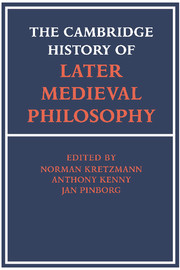 The Cambridge History of Later Medieval Philosophy
The Cambridge History of Later Medieval Philosophy Book contents
- Frontmatter
- Introduction
- I Medieval philosophical literature
- II Aristotle in the middle ages
- 2 Aristoteles latinus
- 3 The medieval interpretation of Aristotle
- III The old logic
- IV Logic in the high middle ages: semantic theory
- V Logic in the high middle ages: propositions and modalities
- VI Metaphysics and epistemology
- VII Natural philosophy
- VIII Philosophy of mind and action
- IX Ethics
- X Politics
- XI The defeat, neglect, and revival of scholasticism
- Index nominum
- Index rerum
- References
3 - The medieval interpretation of Aristotle
from II - Aristotle in the middle ages
Published online by Cambridge University Press: 28 March 2008
- Frontmatter
- Introduction
- I Medieval philosophical literature
- II Aristotle in the middle ages
- 2 Aristoteles latinus
- 3 The medieval interpretation of Aristotle
- III The old logic
- IV Logic in the high middle ages: semantic theory
- V Logic in the high middle ages: propositions and modalities
- VI Metaphysics and epistemology
- VII Natural philosophy
- VIII Philosophy of mind and action
- IX Ethics
- X Politics
- XI The defeat, neglect, and revival of scholasticism
- Index nominum
- Index rerum
- References
Summary
Clerical and Aristotelian science
The question of the interpretation of Aristotle in the Middle Ages must be dealt with within the context of the medieval conception of science. Medieval learning was characterised by an attitude which was dominant – though in varying degrees and varying circumstances – from the time of Alcuin to that of Bellarmine. For the Middle Ages it was not the individual who taught, but the Church, through the clergy. Clerical science was accordingly the corporate transmission of traditional wisdom. The cleric was a ‘master’ chosen by God to teach his people the way of salvation, as Rhabanus Maurus put it at the beginning of his De institutione clericorum. His authority as a teacher was guaranteed by a divine call within the ecclesiastical hierarchy; the authority of his teaching was guaranteed by Scripture and the Church Fathers. But his authority extended even beyond the sacred sciences, in a way which reveals the relationships between this clerical attitude towards knowledge and the structure of medieval society. The relationship between the clergy and the laity is clearly symbolised in Alcuin's Dialectica, a dialogue in which Alcuin as magister instructs Charlemagne himself as discipulus, in one of the profane sciences of the trivium and quadrivium.
Within this conception of the scientific enterprise a standard method of interpretation was developed based on the presumed concordance of the fundamental authorities, and schools evolved whose function was the training of masters who should transmit traditional learning to God's people.
- Type
- Chapter
- Information
- The Cambridge History of Later Medieval PhilosophyFrom the Rediscovery of Aristotle to the Disintegration of Scholasticism, 1100–1600, pp. 80 - 98Publisher: Cambridge University PressPrint publication year: 1982
References
- 15
- Cited by
